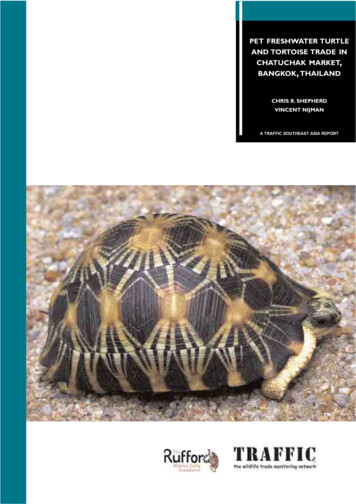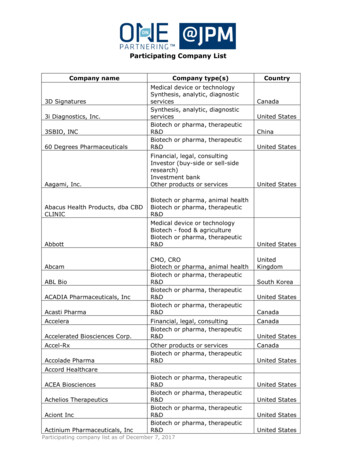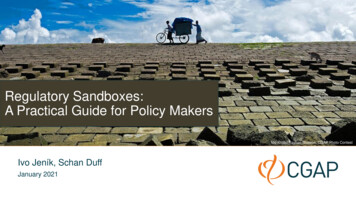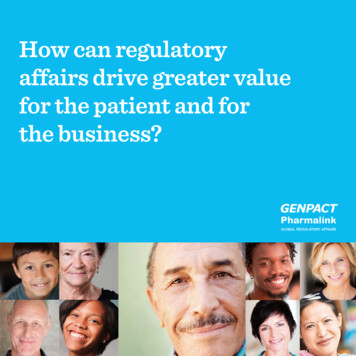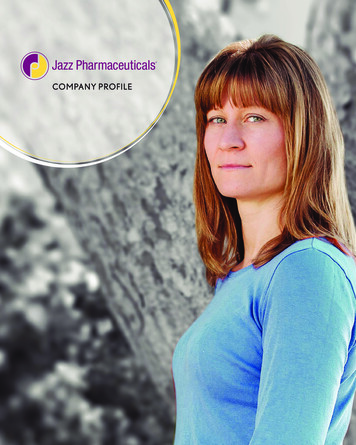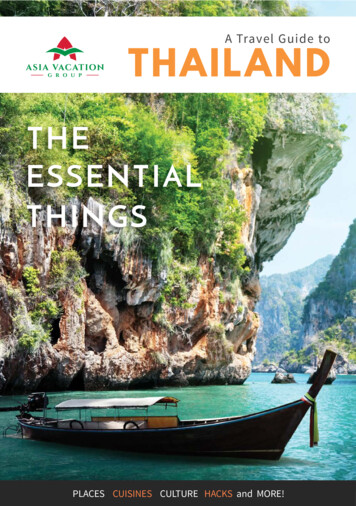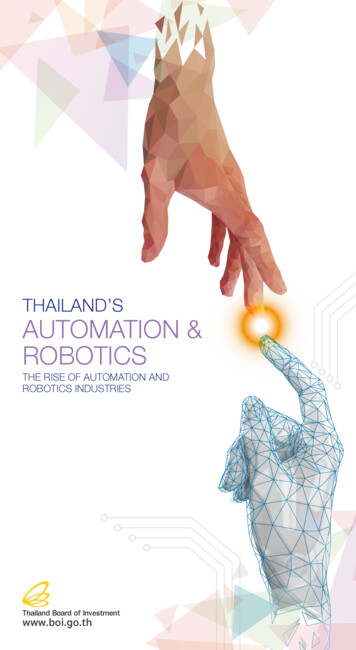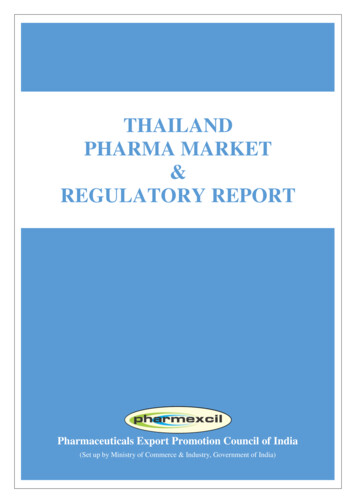
Transcription
THAILANDPHARMA MARKET®ULATORY REPORTPharmaceuticals Export Promotion Council of India(Set up by Ministry of Commerce & Industry, Government of India)Pharmexcil, HyderabadJuly 2020Page 186
CONTENTSDEMOGRAPHY . 188MARKET REPORT . 189INTRODUCTION. 189Latest Updates. 189Strengths . 189Weaknesses . 189Market Overview . 190Epidemiology . 191Generic Market . 191Pharmaceutical Trade Forecast. 192Regulatory Review . 192Local Industry . 194Statistics: . 195Imports of Thailand . 195REGULATORY AND REGISTRATION REQUIREMENTS . 196Asean Common Technical Documents (ACTD) . 201Procedure of Generic Drugs Registration . 210Pharmexcil, HyderabadJuly 2020Page 187
DEMOGRAPHYSL. No pulation growth rate (%)0.25%(July 2020 est)6GDP (purchasing power parity)1.229 trillion7GDP - real growth rate (%)3.7%8GDP - per capita (PPP)17,8009Exchange rates10Population below poverty line31.5%11Age structure (%)0-14 years: 16.45%15-24 years: 13.02%25-54 years: 45.69%55-64 Years: 13.01%65 Years and above 11.82%Source: CIA World Fact Book updated to on 3rd June 2020Pharmexcil, HyderabadJuly 2020Page 188
MARKET REPORTINTRODUCTIONThailand's pharmaceutical market will continue on a positive growth trajectory. Efforts arebeing made to reform regulatory processes for innovative drug registrations helping Thailandto attract greater foreign investment into its domestic pharmaceutical industry. However,comparatively the low levels of affordability and poor access to healthcare, the market willmainly be suited to generic producers.Market size in 2019 was 5.9bn experiencing a growth of 8.17. It is expected to grow at8.7% in 2020 and reach 6.43 bn.Latest Updates In March 2020, Thailand's Ministry of Public Health officially declared Covid-19(corona virus) a dangerous disease and introduced stricter measures to managetreatment and the spread of the virus. In February, Thailand’s largest hospital operator Bangkok Dusit Medical Services Pcl(BDMS) made an offer to purchase the remaining shares in Bumrungrad Hospital(BH.BK) it does not already own. Also in February 2020, Pfizer Thailand's manager said the company is working withthe Thailand Government to find different healthcare related partnerships between thetwo to help improve Thailand's healthcare access. In February 2020, Thai pharmaceutical company Siam Bioscience (SBS) and theCuban medicine industry agreed a joint venture to begin manufacturing cancer drugs.Strengths Established universal healthcare scheme, resulting in improved access to healthcare. Strong hospital sector growth reflecting the ongoing modernization of the healthcareindustry. Significant pharmaceutical market growth potential, highly reliant on government'sinterest in developing the pharmaceutical sector. Government measures to reduce the cost of pharmaceuticals by promoting aconsumption shift towards generic drugs.Weaknesses Low pharmaceutical spending per capita.High levels of counterfeit and parallel imported medicines in the country.Uncertain pricing regulation and low levels of intellectual property protection.Government drug reimbursement policy heavily biased towards local drug producersand excluding many modern medicines.Pharmexcil, HyderabadJuly 2020Page 189
Market OverviewThailand's pharmaceutical market has grown significantly in the past few years due toimpressive developments in the public healthcare system. However, in order for thegovernment to achieve its goals for life expectancy and other key areas, the healthcare sectorwill need to receive increased and effective investment over the long term. Limited statecoverage of medicines and a lack of doctors currently inhibit the market.In 2019, Thailand's pharmaceutical market was valued at USD5.9bn. In 2020 forecasts showthat the market might grow by 4.5%, reaching a value of USD6.4bn. Over the forecast periodto 2024, it is expected that the pharmaceutical market will reach a value of USD6.9bn,undergoing a compound annual growth rate (CAGR) of 3.1%. Per capita spending on Pharmawas 84.9.Thailand represents a significant growth opportunity for multinational pharmaceutical firmslooking to expand their presence into the emerging markets of Asia Pacific. In addition, whilestill an underdeveloped market with respect to developed APAC countries, itis one of themore developed in the region, providing both potential for growth and a relatively businessfriendly environment. The market's growth will be driven predominantly by the imminenttransformation of the healthcare system, which will provide a rapid increase in accessibilityto medical services. Rapid urbanisation and the low costs of manufacturing and R&Dassociated with government support are also paving the way to make Thailand a regional hubfor innovation. Growing healthcare needs have also prompted the government to make longterm investments. The country has also become a popular destination for drug clinical trialsowing to its developing healthcare system and medical infrastructure. Clinical trials inThailand are cost-efficient, and the government’s Board of Investment actively promotesThailand as a prime destination to conduct clinical research.However, with the rapidly rising demand for and consumption of drugs, the country’sgovernment is likely to face sustainability issues in ensuring the populations' access tomedicines in a cost-effective manner. The government in particular has a strong incentive torationalise spending as it contributes substantially to healthcare financing, with the majorityof the Thai population covered by one of three government healthcare schemes. Due togreater scrutiny on healthcare spending, increasingly forceful medicine pricing pressures arelikely continue over the coming years which will, in turn, squeeze revenue-earningopportunities of innovative drug makers. Critics feel Political instability is also a pertinentrisk to the pharmaceutical market’s growth outlook, especially as it could deter foreigninvestment to the country.Pharmexcil, HyderabadJuly 2020Page 190
EpidemiologyThe rising burden of non-communicable and communicable diseases in Thailand presents ahighly attractive epidemiological profile for pharmaceutical companies. This commercialopportunity is further complemented by the government's strong commitment to improveaccess to medicines through its universal healthcare programme.Cardiovascular conditions, diabetes and cancer account for a large and growing burden ofdisease. The growth of non-communicable diseases in Thailand poses a heavy economicburden on the country. Non-communicable diseases exert significant financial pressures onthe Thai population.HIV/AIDS is a prevalent problem in Thailand, with the Department of Disease Controlestimating that the cumulative number of cases will exceed 1.25mn by 2020.Like other countries in the Western Pacific region, Thailand is facing increasing numbers ofpatients with diabetes due to unhealthy diets, high obesity rates, and an ageing society. Mostrecent estimates of the International Diabetes Federation, report that there are about 4.2mnpeople with diabetes as of 2017.According to Globocan, the number of new cancer cases in Thailand is forecast to rise from123,801 in 2012 to 168,039 by 2025. In Thailand, five cancer types (breast, cervical,colorectal, liver and lung cancer) contribute to over half of the cancer burden.Generic MarketThe generic medicine market will continue to grow at a faster pace than the overallpharmaceutical market, gaining in market share over the forecast period. This trend will besupported by the government's focus on cost containment, the current pricing andreimbursement policies.Generic medicines will remain an important segment within Thailand's pharmaceuticalmarket. Forecasts show that generic drug market spending to increase from USD2.9bn in2019 to, USD3.2bn in 2020 and to USD3.4bn by 2024, equating to a five-year CAGR of3.1%.Pharmexcil, HyderabadJuly 2020Page 191
In 2019 generic drugs accounted for 60.7% of prescription drug sales and 49.0% of totalsales.Thailand's poor regulatory environment - defined by its weak patent enforcement and anunpredictable and delayed reimbursement system - will continue to limit the attractiveness ofthe country to innovative drug makers. Therefore, in addition to the increasing pressures onmedicine pricing due to the country's low per capita healthcare expenditure, the demand forcheaper generic medicines will rise at the expense of the innovative market.Pharmaceutical Trade ForecastThailand is highly dependent on pharmaceutical imports and has trade deficit. Imports arelikely to continue to increase, further augmented by the rising demand for medicines as thecountry's disease burden grows. While exports will see a faster growth over the forecastperiod, but from a low base, with the majority of domestic drug makers remaining focused inlow-value generic drugs.In 2019, pharmaceutical imports were valued at USD 2.5bn. This is forecast to grow toUSD2.9bn by 2024 with a five-year compound annual growth (CAGR) of 3.1%. Incomparison, Thailand's pharmaceutical export value was USD 0 .48bn in 2019, which isforecast to rise to USD0.5bn by 2024 with a five year compound annual growth (CAGR) of1.1%.Growth in export of the pharmaceuticals and medical supplies sector has been slow and,because most exports are of low-value generics, a large share of exports go to neighboringcountries, with Vietnam, Myanmar, the Philippines and Cambodia accounting for 57% of thetotal.Imports, on the other hand, tend to be of high-value products which the domestic sector isunable to produce. This includes products such as erythropoietin, antibiotics and cholesterollowering medications. The main exporters to Thailand are Germany, the US and France. It isworth noting that in the last two to three years, there has been a significant increase in thevalue of imports from India. However, it is believed that future import growth of high-valuemedicines will be somewhat restricted by the government's ongoing cost-containmentpolicies and strict pricing controls in order to manage rising medicines demand. These desiresto contain costs are likely to be reflected in a change in the source of imports, with a growingrole for generics in particular.Regulatory ReviewThe main regulatory body of the pharmaceutical sector in Thailand is the Thai Food & DrugAdministration (FDA), which operates under the auspices of the Ministry of Public Health.The Thai FDA has attempted to gain Cabinet endorsement for a new draft Drug Act since1999, but the legislation continues to be referred back to the Ministry of Public Health. Theproposed Drug Act is designed to promote a prescription system in Thailand, which willnecessitate drug reclassification to fill in the three lists, namely prescription-only, pharmacyonly and OTC.The Ministry of Public Health is the principal agency responsible for promoting, controllingand coordinating all health activities.Thailand Drug RegistrationPharmexcil, HyderabadJuly 2020Page 192
The Thai FDA requires importers and manufacturers in Thailand to obtain approval prior toimporting or manufacturing. The Thai FDA categorizes drugs into modern general medicines,traditional medicines and veterinary medicines, each having a separate registrationrequirement. General medicines are grouped into separate categories of generic medicines,new medicines and new generics. Each category of medicines has a distinct set ofrequirements. The Thai FDA issues drug licenses for indefinite periods of time.Biosimilar RegistrationIn October 2013, the Thai FDA published a notification regarding drug registration dossiersfor biosimilars, requiring applicants of biosimilar products to provide the followinginformation: Information regarding the biological substance, its manufacturing process and thecomparative physicochemical characterization between the biosimilar and the referencebiological product. Non-clinical and clinical trial data of comparison studies between the biosimilar andreference biological product. A risk management plan.To address ever-increasing healthcare costs, Thailand is promoting the entry of biosimilars.With a focus on quality, efficacy and safety, there is now a distinct registration pathway forbiosimilar products. The intellectual property protection available for these innovativeproducts remain uncertain because of the novel and innovative nature of biological productsas compared to chemical drugsOthers RegistrationsTraditional medicine (TM) is widely used in the country (and known as Traditional ThaiMedicine, TTM), although its integration into the mainstream healthcare system is not astandard. Nevertheless, TMs continue to receive attention. For example, the 2017 TraditionalMedicine International Development forum, organized by the Naresuan University and theGuangdong-Macau Traditional Medicine Technology Industry Park Development (GMTCMPark) was held in Thailand. The meetings specifically focused on policy-making, academicresearch and commercial topics related to traditional medicines. A number of prominent localand regional stakeholders took park in the forum, including representatives of the Thai FDA,Thai Traditional Chinese Medicine Doctor Association, Faculty of Public Health and theDepartment of Thai Traditional and Alternative Medicine. Marketing approval (that is, a drugregistration certificate) from the FDA is generally required for traditional medicines.However, the Drug Act exempts traditional herbal medicines from this requirement.Therefore, traditional herbal medicines do not have to be registered with the FDA. Only amanufacturing, sales or import license is required.Generic Medicines RegulationIn August 2011, the Thai FDA announced plans to amend the requirement regulatingbioequivalence studies of new generic drugs. This change is made in an effort to expedite thedrug approval process and provide more patients access to generic drugs in Thailand in thenear future.Pharmexcil, HyderabadJuly 2020Page 193
This amendment will allow pharmaceutical companies that want to register new genericdrugs to submit bioequivalence study results from foreign institutes or laboratories.Previously, foreign bioequivalence studies were not accepted by the Thai FDA as part of thedrug registration process. Drug companies must submit the dossiers within 120 days after theforeign bioequivalence study is completed. The Thai FDA will limit registration applicationsto no more than one new generic drug at a time per company. The applying pharmaceuticalcompanies need to supply all documents and necessary information for the drug registrationin a timely manner.Local IndustryMultinational pharmaceutical companies account for the majority of research-based firms inThailand and are largely represented by the Pharmaceutical Research and ManufacturersAssociation (PReMA), previously known as the Pharmaceutical Producers Association.Established in 1970, PReMA now represents 42 members employing a collective workforceof around 12,000 staff. PReMa is a member of the International Federation of PharmaceuticalManufacturers' Associations and the World Self-Medication Industry. It is also representedon some government committees concerned with health matters.The Thai authorities recently selected the healthcare sector as one of the 10 industries to growand decided to abolish exclusive drug supply privileges previously granted to state-ownedcompanies. The government aims to attract foreign firms and enhance the competitiveness ofthe local drug sector. The Thailand Board of Investment (BOI) also grants incentives topharmaceutical investors. Companies engaged in the manufacture of pharmaceutical productsor active ingredients are eligible for tax holidays anda range of non-tax benefits, includingprivileges on imported equipment duties.Furthermore, with the aim of increasing investor confidence by resolving the patent backlogissue and improving the examination process for the newly filed applications, the Ministry ofCommerce and National Council for Peace and Order, along with the Department ofIntellectual Property, proposed amendments to the Patents Act in February 2017 to permitfaster and more efficient examination of applications. The reforms to improve the regulatorylandscape will be a step towards boosting innovation in research and development andallowing new medicines to enter the market quickly. In addition, this will serve to benefit thegrowing demand of medicines driven by the country's rising disease burden, robust healthcareaccess under the universal healthcare system and the country's thriving medical tourismsector.Major international pharmaceutical companies either have manufacturing facilities inThailand or source products from Thai drug manufacturers. The country has also become apopular destination for drug clinical trials because of its developing healthcare system andmedical infrastructure. Clinical trials in Thailand are cost efficient and there is a large patientpopulation. In addition, the government’s Board of Investment actively promotes Thailand asa prime destination to conduct clinical research.Most of the domestic pharmaceutical companies are engaged in packaging of imported drugsand production of generics and do not have a prominent focus on R&D. Owing to thegovernment's aim to endorse generics to shrink the healthcare burden, domesticpharmaceutical companies shy away from investing in R&D.Pharmexcil, HyderabadJuly 2020Page 194
The Governmental Pharmaceutical Organization (GPO) is the leading local organisationfocusing primarily on manufacturing generic drugs and holds exclusive rights to supplygovernment hospitals with products within the National List of Essential Drugs.Moreover, the GPO's generic product registration is timely and requires minimaldocumentation in comparison to standard regulatory procedures. According to the regulationsof the office of Prime Minister of Procurement in 1992, Thai government organisations arerequired to buy pharmaceutical products manufactured by the GPO. Public hospitals arelegally obliged to allocate60% of their budget to purchase NLED-listed and GPO-producedmedicines, while hospitals attached to the Thai Ministry of Public Health must allocate 80%of their budget towards purchasing drugs from the GPO.Statistics:India Pharma exports to Thailand by Category Million20152016Category1617Bulk Drugs & Drug Intermediates 58.6353.13Drug Formulations & Biologicals78.5476.21Ayush0.170.29Herbal tal147.54 ’s exports of Pharmaceuticals to Thailand MnCategoryFy-19Bulk Drugs & Drug Intermediates63.56Drug formulations & Biologicals110.59Ayush0.32Herbal .79-3.88Imports of ThailandTop Ten Formulations Importing Partners of Thailand ia123.19136.86114.265Switzerland 7116.74110.18Pharmexcil, HyderabadJuly .557.096.015.944.824.36Page 195
3123.70100.00REGULATORY AND REGISTRATION REQUIREMENTS Regulatory AuthorityAdministration:Thai Food and Drug(FDA), Thailand Website of regulatory Authority:http://www.fda.moph.go.th/ Fees for Drug Registration:25000 THB Normal time taken for registration:18 Months Registration Requirement [DossierFormat]:ACTDPharmexcil, HyderabadJuly 2020Page 196
Whether plant inspection is mandatory:No Validity of Registration:5 YearsHistorical BackgroundThe protection of consumers' health in Thailand can be traced back as far as 1909 — theconcerning rise of illegal activities brought about by the influx of products counterfeited andcontaminated raised a significant alarm. The agencies which were subsequently establishedthen have been numerously transformed through time, and the scope of their responsibilitieshas been broadened to keep pace with the dynamic contemporary social changes of publichealth security.Here is a summary of some key events which occurred prior the birth of the Thai Food andDrug Administration (Thai FDA): In 1922, the Narcotics Act was promulgated. This was the occasion of theestablishment of the Narcotics Division, which was then under the Public HealthDepartment, Ministry of the Interior.In 1937, the Narcotics Division was restructured and renamed the Food and DrugDivision.In 1942, the Consumer Support Division, a division of the Department of PublicWelfare, was integrated with the Food and Drug Division. There were three subdivisions in this new structure: Food, Drugs, and Statistics & Registration.In 1953, the Food and Drug Division was transferred to the Office of the PermanentSecretary, Ministry of Public Health. The name of the division was changed to theFood and Drug Control Division.In 1972, the Food and Drug Control Division was transferred as a division under theDepartment of Health Promotion and the Regional Inspection Subdivision wasestablished.In 1974, a major change took place: the Food and Drug Control Division waspromoted to become a department and named the Food and Drug Administration. Thenew organization was originally divided into eight divisions: Food Control, DrugControl, Cosmetics Control, Narcotics Control, Inspection, Technical, PublicRelations and Advertising Control, and the Office of the Secretary.In 1985, the Legal Affairs Task Group, which was formerly under the Office of theSecretary, was established directly under the FDA Secretary-General.In 1990, two new divisions were set up. They were the Medical Device Control andthe Toxic Substance Control.In 1992, there were 10 divisions: Food Control, Drug Control, Cosmetics Control, ToxicSubstances Control, Narcotics Control, Inspection, Technical, Medical Devices Control,Public Relations and Advertising Control, and the Office of the Secretary. There were alsothree small internal entities: the Legal Affairs Task Group, the Rural Consumer HealthProtection Promotion Group and the Office of Experts.From 2003 to the present, in order to streamline working processes in line with governmentpolicies, the FDA has been restructured into six product control units (4 Bureaus and 2Divisions) and four supportive units as described in the following section.MissionPharmexcil, HyderabadJuly 2020Page 197
1. Regulate and monitor health products to meet quality, safety and efficacy as standards inaccordance with international laws.2. Promote and support the capability of consumers to gain knowledge, understanding andgood consumption behaviour of healthy products.3. Promote and enhance international competitiveness of all stakeholders and nongovernment parties.The Roles and Responsibilities of Thai FDAThe main role of Thai FDA is to protect consumers' health thru ensuring safety, quality andefficacy of consumable products within its remit. These include: foods, drugs, psychotropicsubstances, narcotics, medical devices, volatile substances, cosmetics and hazardoussubstances available in the country. This has to be implemented in accordance with thenational legislation and international agreements as follows:1. Drug Act, B.E. 2510 (1967) and Amendment No. 2 (1975), No. 3 (1979), No. 4(1985) and No. 5 (1987),2. Psychotropic Substance Act B.E. 2518 (1975) and Amendment No. 2 (1985), No. 3(1992) and No. 4 (2000)3. Food Act, B.E. 2522 (1979)4. Narcotic Act, B.E. 2522 (1979) and Amendment No. 2 (1985), No. 3 (1987) and No.4 (2000)5. The Emergency Decree on Prevention of Abuse of Volatile Substances, B.E. 2533(1990) and Amendment No. 2 (2000)6. Hazardous Substance Act, B.E. 2535 (1992)7. Medical Device Act, B.E. 2551 (2008)8. Cosmetic Act, B.E. 2558 (2015)9. The Single Convention on Narcotic Drugs 1961, commentary on the protocolamended in Geneva on March 25, 197210. The International Convention on Psychotropic Substances, 197111. The International Code of Marketing of Breast Milk Substitute, 198112. The United Nation Convention Against Illicit Traffic in Narcotic Drugs andPsychotropic Substances, 1988.By law, certain important issues are decided by committees, whose members, all experts intheir fields, are appointed by the Minister of Public Health. Currently, there are sixcommittees: Drugs, Foods, Cosmetics, Narcotics, Psychotropic Substances and MedicalDevices.There are two committees whose members are appointed by the other ministries. They are theCommittee on the Prevention of Abuse of Volatile Substances appointed by two ministers(Industry and Public Health), and the Hazardous Substance Committee appointed by threeministers (Public Health, Industry and Agriculture).At the national level, the Cabinet appoints three committees: the National Drug Committee,the National Food Committee and the National Chemical Safety Committee. The nationalcommittees mainly assign policies, developmental issues and collaborative activities withother agencies to facilitate the implementation of the food, drug and chemical safety programas well as the control system.The roles and responsibilities of the FDA may be grouped into five main areas:1. Pre-marketing ControlPharmexcil, HyderabadJuly 2020Page 198
This includes control of manufacturing facilities, product quality and advertisingbefore product-launch to the market. In each case, compliance is required with therelevant legislation and regulations.2. Post-marketing ControlThe aim of this activity is to investigate manufacturing facilities and product qualityand to ensure that they maintain compliance with previously-approved standards andwith legislation and regulations.For example, samples of products are regularly inspected and taken to check forcompliance and quality. Previously-approved products are revisited periodically toascertain the consistency of manufacturing and product standards over time.3. Surveillance Program for Consumers' SafetyThe aim of this program is to detect any adverse effects or unexpected outcomes fromconsumer use of products. Research and epidemiological data on adverse effects,including technical information, are collected, summarized, interpreted and reported.There are also operational centres, such as the Adverse Product Reaction MonitoringCentre (APRMC) and the International Program on Chemical Safety (IPCS).Information is exchanged with other agencies at local and international level.4. Consumer EducationConsumers are supplied with sufficient, accurate information to enable them tochoose products wisely. Access to such information, provided by the FDA, isavailable from many sources: television, radio, newspaper, leaflets, internet, and otheravailable media. FDA's campaigns on priority topics have been regularly conducted indepartment stores, schools and villages in many parts of the country. There are manysources for consumers to use so that they can obtain further useful information and bein a better position to protect their selves.5. Technical Support and Cooperation with other AgenciesThe FDA has conducted many interesting seminars and workshops, with participantsfrom both public and private sectors. On the other hand, officials from the Thai FDAare sent to join seminars and conferences, both local and abroad. As a result, with awidened perspective, they can work more effectively at home. The GoodManufacturing Practice (GMP) program is another example demonstrating successfulcooperation with other organizations, in this case, with universities and drugmanufacturers.In relation to cooperation in terms of research and development, the FDA is continuallysupportive of such endeavour, and some research projects are partly or wholly funded by theagency.Organization Structure of Thai FDACurrently, Thai FDA is under the cluster of Public Health Service Support under the Ministryof Public Health. This is a group of departments working on an integrated program in order toachieve greater efficiency and effectiveness. The Cluster of Public Health Se
Regulatory Review The main regulatory body of the pharmaceutical sector in Thailand is the Thai Food & Drug Administration (FDA), which operates under the auspices of the Ministry of Public Health. The T
